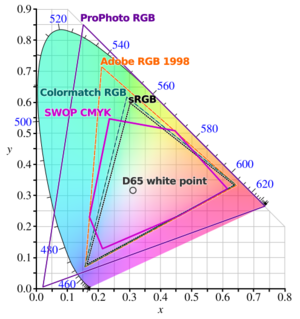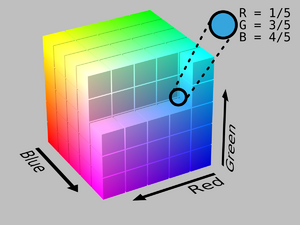RGB color spaces
An RGB color space is one of many specific additive colorimetric color spaces based on the RGB color model.[1][2]
RGB color spaces are commonly found describing the physical output of display devices such as television screens and computer monitors, but some RGB color spaces use imaginary primaries and can not be displayed directly.
Definition
The normal human eye contains three types of color-sensitive cone cells. Each cell is responsive to light of either long, medium, or short wavelengths, which we generally categorize as red, green, and blue. Taken together, the responses of these cone cells are called the Tristimulus values, and the combination of their responses is processed into the psychological effect of color vision.
An RGB color space is defined by:
- Chromaticity coordinates of the red, green, and blue additive primaries.
- Chromaticity of the white point, which is usually a standard illuminant.
- The transfer function, also known as the tone response curve (TRC) or gamma, that maps chromaticity to tristimulus values.
An RGB color space uses primaries based on the RGB color model. Mixing of the three primaries in different proportions then creates the perception of colors other than the primaries. Applying Grassmann's law of light additivity, the range of colors that can be produced are those enclosed within the triangle on the chromaticity diagram defined using the primaries as vertices. The TRC and white point further define the possible colors, creating a volume of encodable colors enclosed within the 3D-triangle.[3]
The primary colors are usually specified in terms of their xyY chromaticity coordinates, though the uʹ,vʹ coordinates from the UCS chromaticity diagram may be used. Both xyY and uʹ,vʹ are derived from the CIE 1931 color space, a device independent space also known as XYZ which covers the full gamut of human-perceptible colors visible to the CIE 2° standard observer.
Applications
RGB color spaces are well-suited to describing the electronic display of color, such as computer monitors and color television. These devices often reproduce colours using an array of red, green, and blue phosphors agitated by a cathode ray tube (CRT), or an array of red, green, and blue LCDs lit by a backlight, and are therefore naturally described by an additive color model with RGB primaries.
Early examples of RGB color spaces came with the adoption of the NTSC color television standard in 1953 across North America, followed by PAL and SECAM covering the rest of the world. These early RGB spaces were defined in part by the phosphor used by CRTs in use at the time, and the gamma of the electron beam. While these color spaces reproduced the intended colors using additive red, green, and blue primaries, the broadcast signal itself was encoded from RGB components to a composite signal such as YIQ, and decoded back by the receiver into RGB signals for display.
HDTV uses the BT.709 color space, later repurposed for computer monitors as sRGB. Both use the same color primaries and white point, but different transfer functions, as HDTV is intended for a dark living room while sRGB is intended for a brighter office environment.[citation needed] The gamut of these spaces is limited, covering only 35.9% of the CIE 1931 gamut.[4] While this allows the use of a limited bit depth without causing color banding, and therefore reduces transmission bandwidth, it also prevents the encoding of deeply saturated colors that might be available in an alternate color spaces. Some RGB color spaces such as Adobe RGB and ProPhoto intended for the creation, rather than transmission, of images are designed with expanded gamuts to address this issue, however this does not mean the larger space has 'more colors". The numerical quantity of colors is related to bit depth and not the size or shape of the gamut. A large space with a low bit depth can be detrimental to the gamut density and result in high [math]\displaystyle{ \Delta E }[/math] errors[further explanation needed].
More recent color spaces such as Rec. 2020 for UHD-TVs define an extremely large gamut covering 63.3% of the CIE 1931 space.[5] This standard is not currently realisable with current LCD technology, and alternative architectures such as quantum dot[6] or OLED[7] based devices are currently in development.
RGB color space specifications
| Color space | Reference Standard | Year | White point | Primaries | Display | Transfer function parameters | |||||||||
|---|---|---|---|---|---|---|---|---|---|---|---|---|---|---|---|
| Red | Green | Blue | γ | α | β | δ | βδ | ||||||||
| xʀ | yʀ | xɢ | yɢ | xʙ | yʙ | EOTF | a + 1 | K0/φ = Et | φ | K0 | |||||
| NTSC-J | Based on NTSC(M) | 1987 | D93 | 0.63 | 0.34 | 0.31 | 0.595 | 0.155 | 0.07 | 2.5 | |||||
| NTSC, MUSE | SMPTE RP 145 (C), 170M, 240M | 1987 | D65 | 20/9 | 1.1115 | 0.0057 | 4 | 0.0228 | |||||||
| Apple RGB | (Apple Computer) | 0.625 | 0.28 | 1.8 | |||||||||||
| PAL / SECAM | EBU 3213-E, BT.470/601 (B/G) | 1970 | 0.64 | 0.33 | 0.29 | 0.60 | 0.15 | 0.06 | 2.8 | 14/5 | |||||
| sRGB | IEC 61966-2-1 | 1996, 1999 | 0.30 | 2.2 | 12/5 | 1.055 | 0.0031308 | 12.92 | 0.04045 | ||||||
| scRGB | IEC 61966-2-2 | 2003 | |||||||||||||
| HDTV | ITU-R BT.709 | 1999 | 2.4 | 20/9 | 1.099 | 0.004 | 4.5 | 0.018 | |||||||
| Adobe RGB | (Adobe) | 1998 | 0.21 | 0.71 | 2.2 | 563/256 | |||||||||
| M.A.C. | ITU-R BO.650-2[8] | 1985 | 0.67 | 0.14 | 0.08 | 2.8 | |||||||||
| NTSC-FCC | ITU-R BT.470/601 (M) | 1953 | C | 2.2[9] | 11/5 | ||||||||||
| PAL-M | ITU-R BT.470-6[10] | 1972 | |||||||||||||
| eciRGB | ISO 22028-4 | 2008, 2012 | D50 | 1.8 | 3 | 1.16 | 0.008856 | 9.033 | 0.08 | ||||||
| DCI-P3 | SMPTE RP 431-2 | 2011 | 6300K | 0.68 | 0.32 | 0.265 | 0.69 | 0.15 | 0.06 | 2.6 | 13/5 | ||||
| Display P3 | SMPTE EG 432-1 | 2010 | D65 | ~2.2 | 12/5 | 1.055 | 0.0031308 | 12.92 | 0.04045 | ||||||
| UHDTV | ITU-R BT.2020, BT.2100 | 2012, 2016 | 0.708 | 0.292 | 0.170 | 0.797 | 0.131 | 0.046 | 2.4 | 1.0993 | 0.018054 | 4.5 | 0.081243 | ||
| Wide Gamut | (Adobe) | D50 | 0.7347 | 0.2653 | 0.1152 | 0.8264 | 0.1566 | 0.0177 | 2.2 | 563/256 | |||||
| RIMM | ISO 22028-3 | 2006, 2012 | 0.7347 | 0.2653 | 0.1596 | 0.8404 | 0.0366 | 0.0001 | 2.222 | 20/9 | 1.099 | 0.0018 | 5.5 | 0.099 | |
| ProPhoto (ROMM) | ISO 22028-2 | 2006, 2013 | 0.734699 | 0.265301 | 0.159597 | 0.840403 | 0.036598 | 000105 | 1.8 | 9/5 | 1 | 0.001953125 | 16 | 0.031248 | |
| CIE RGB | CIE 1931 color space | 1931 | E | 0.73474284 | 0.26525716 | 0.27377903 | 0.7174777 | 0.16655563 | 0.00891073 | ||||||
| CIE XYZ | 1 | 0 | 0 | 1 | 0 | 0 | 1 | ||||||||
The CIE 1931 color space standard defines both the CIE RGB space, which is an RGB color space with monochromatic primaries, and the CIE XYZ color space, which is functionally similar to a linear RGB color space, however the primaries are not physically realizable, thus are not described as red, green, and blue.
M.A.C. is not to be confused with MacOS. Here, M.A.C.refers to Multiplexed Analogue Components.
See also
- CIELUV color space
- Web colors
- RGB color model
- RGBA color model
References
- ↑ "colorimetric colour space (definition)". France: International Commission on Illumination (CIE). https://cie.co.at/eilvterm/17-23-042.
- ↑ Pascale, Danny. "A Review of RGB color spaces...from xyY to R'G'B'". http://www.babelcolor.com/download/A%20review%20of%20RGB%20color%20spaces.pdf.
- ↑ Hunt, R. W. G (2004). The Reproduction of Colour (6th ed.). Chichester UK: Wiley–IS&T Series in Imaging Science and Technology. ISBN 0-470-02425-9. https://archive.org/details/reproductionofco0000hunt.
- ↑ Yamashita, Takayuki; Nishida, Yukihiro; Emoto, Masaki; Ohmura, Kohei; Masaoka, Kenichiro; Masuda, Hiroyasu; Sugawara, Masayuki. "Super Hi-Vision as Next-Generation Television and Its Video Parameters". http://informationdisplay.org/IDArchive/2012/NovemberDecember/FrontlineTechnologySuperHiVisionasNextGen.aspx.
- ↑ Baker, Simon (19 February 2014). "The Pointer's Gamut - The Coverage of Real Surface Colors by RGB Color Spaces and Wide Gamut Displays" (in en). https://tftcentral.co.uk/articles/pointers_gamut.
- ↑ Chen, Haiwei; He, Juan; Wu, Shin-Tson (September 2017). "Recent Advances on Quantum-Dot-Enhanced Liquid-Crystal Displays". IEEE Journal of Selected Topics in Quantum Electronics 23 (5): 1–11. doi:10.1109/JSTQE.2017.2649466. Bibcode: 2017IJSTQ..2349466C. https://ieeexplore.ieee.org/document/7809081.
- ↑ Huang, Yuge; Hsiang, En-Lin; Deng, Ming-Yang; Wu, Shin-Tson (18 June 2020). "Mini-LED, Micro-LED and OLED displays: present status and future perspectives" (in en). Light: Science & Applications 9 (1): 105. doi:10.1038/s41377-020-0341-9. PMID 32577221. Bibcode: 2020LSA.....9..105H.
- ↑ "RECOMMENDATION ITU-R BO.650-2 *,** | Standards for conventional television systems for satellite broadcasting in the channels defined by Appendix 30 of the Radio Regulations". https://extranet.itu.int/brdocsearch/R-REC/R-REC-BO/R-REC-BO.650/R-REC-BO.650-2-199203-I/R-REC-BO.650-2-199203-I!!PDF-E.pdf#page=18.
- ↑ 47 CFR § 73.682 (20) (iv)
- ↑ "Recommendation ITU-R BT.470-6 | Conventional Television Systems". https://www.itu.int/dms_pubrec/itu-r/rec/bt/R-REC-BT.470-6-199811-S!!PDF-E.pdf#page=2.
External links
- RGB Color Chart.
- "Three component color encoding registry". International Color Consortium (ICC). https://www.color.org/chardata/rgb/rgb_registry.xalter.
- Susstrunk, Buckley and Swen. "Standard RGB Color Spaces" (PDF). http://infoscience.epfl.ch/getfile.py?mode=best&recid=34089.
- Lindbloom, Bruce. "RGB Working Space Information". http://www.brucelindbloom.com/index.html?WorkingSpaceInfo.html.
- Colantoni, Philippe. "RGB cube transformation in different color spaces". http://www.couleur.org/index.php?page=rgbcube.
 |




